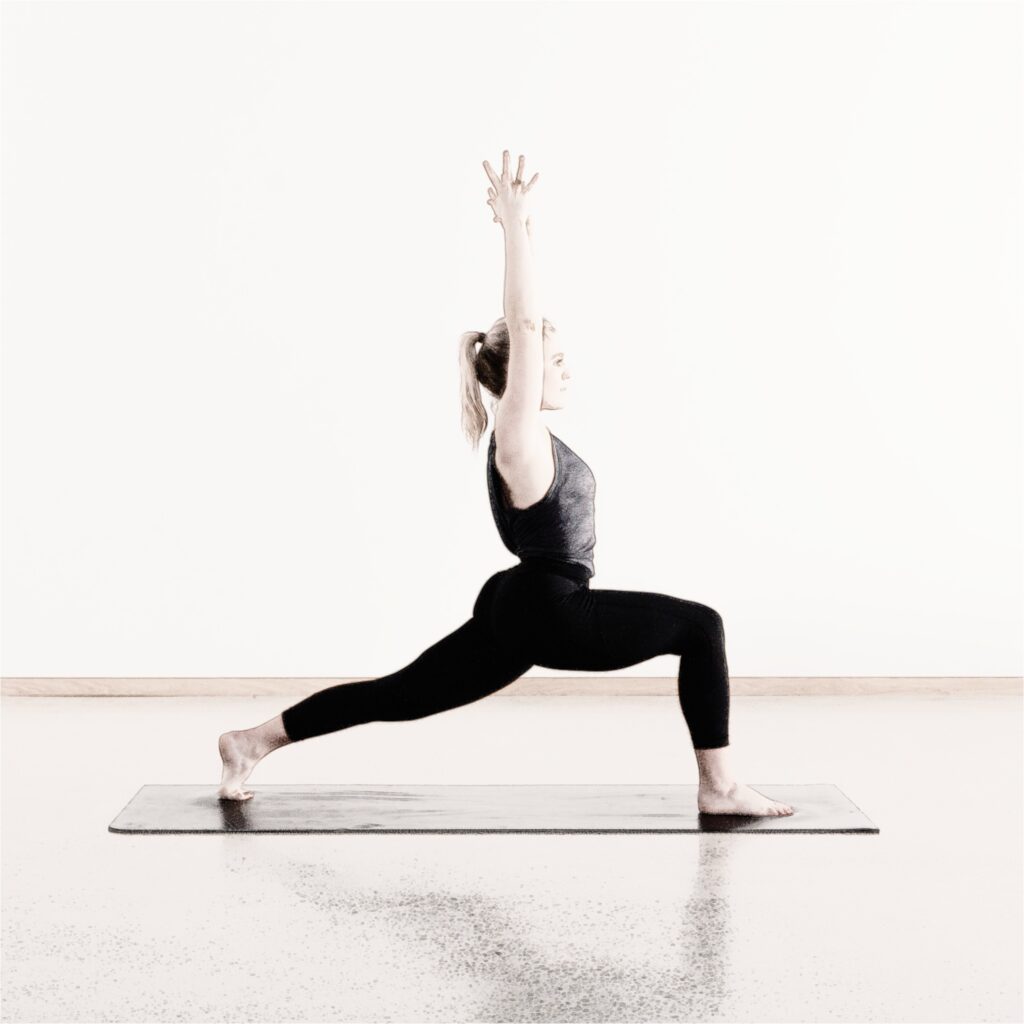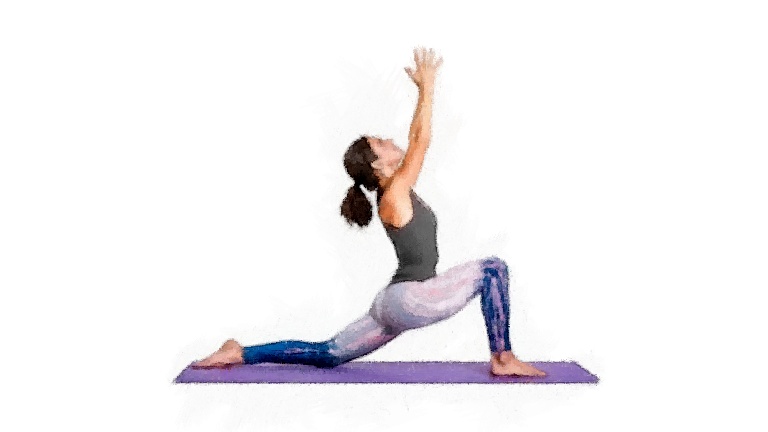Table of Contents
Introduction
Yoga is a practice that has been around for centuries and has been gaining popularity in recent times due to its numerous benefits. It is an excellent way to improve flexibility, strength, and balance, while also promoting relaxation and mindfulness. One pose that is a staple in many yoga sequences is Anjaneyasana, also known as the low lunge pose. In this blog, we will explore Anjaneyasana in detail, including its benefits, variations, and how to practice it correctly.
The yogic philosophy of the Anjaneyasana
Anjaneyasana is a Sanskrit word, where “Anjaneya” means “Lord Hanuman,” and “Asana” means “pose.” Lord Hanuman is a Hindu deity who is known for his strength, devotion, and humility. This pose is named after him as it requires strength, flexibility, and surrender, much like the qualities that Lord Hanuman embodies.

Anjaneyasana is a low lunge pose that stretches the hip flexors, quadriceps, hamstrings, and groin muscles. It also strengthens the legs, core, and upper body, while also improving balance and stability. This pose is commonly found in many yoga sequences, including Sun Salutations, Vinyasa, and Hatha Yoga.
Benefits of Anjaneyasana
Anjaneyasana, also known as the low lunge pose, is a yoga posture that offers many benefits for the body, mind, and spirit. Here are some of the main benefits of practicing Anjaneyasana:

- Stretches leg muscles: Anjaneyasana is great for stretching the muscles in the legs and hips that can become tight from sitting or standing for long periods.
- Strengthens the body: This pose requires strength and stability in the legs and core, which helps to improve overall strength and posture.
- Improves balance and stability: Anjaneyasana challenges the body to maintain a steady posture, which helps improve balance and stability.
- Reduces stress and anxiety: Practicing Anjaneyasana can help reduce stress and anxiety by promoting relaxation and mindfulness.
- Improves digestion and circulation: Anjaneyasana can stimulate digestion and circulation by compressing and releasing the abdominal area.
Overall, practicing Anjaneyasana can have a positive impact on physical and mental health, making it a beneficial addition to any yoga practice.
Crescent Moon Pose: Step-by-Step Instructions
Crescent Moon Pose is a yoga posture that stretches the hips, hamstrings, and quadriceps while also improving balance and stability. Here are the step-by-step instructions to practice Crescent Moon Pose:

- Start in Mountain Pose: Stand with your feet hip-width apart, arms at your sides, and palms facing forward.
- Step back with your left foot: Take a big step back with your left foot, keeping your left heel lifted.
- Bend your right knee: Bend your right knee so that it is directly over your right ankle, making sure your knee doesn’t extend past your ankle.
- Lift your arms: Inhale and lift your arms overhead, bringing your palms together.
- Lengthen your spine: Exhale and lengthen your spine, reaching your arms and fingertips towards the ceiling.
- Lean to the left: Inhale and lean your torso to the left, keeping your arms straight and your palms together.
- Stretch your right side: Exhale and stretch your right side, feeling the stretch in your right hip, hamstring, and quadriceps.
- Hold for several breaths: Hold the pose for several breaths, feeling the stretch in your body.
- Repeat on the other side: To come out of the pose, release your arms and step your left foot forward to meet your right foot. Repeat the pose on the other side.
Anjaneyasana or Crescent Moon Pose is a great pose for beginners and can be easily modified by using a block or cushion under your back foot for support. Remember to breathe deeply and listen to your body as you practice this pose. With regular practice, Anjaneyasana can help improve your balance, flexibility, and overall well-being.
Advance Variations of Anjaneyasana
There are several variations of Anjaneyasana that can be practiced depending on your level of experience and flexibility. Some of the most common variations of this pose are:
- High Lunge: This variation involves lifting the back knee off the ground and extending the arms overhead. This variation strengthens the legs, core, and upper body while also improving balance and stability.
- Low Lunge with a Twist: This variation involves twisting the torso towards the front leg and placing the opposite elbow on the outside of the knee. This variation provides a deeper stretch for the hip flexors and groin muscles while also improving spinal mobility.
- Crescent Lunge: This variation involves lifting the back heel off the ground and extending the arms overhead. This variation provides a deeper stretch for the hip flexors, quadriceps, and groin muscles while also strengthening the legs and upper body.
- Low Lunge with a Quad Stretch: This variation involves reaching back with one hand to grasp the back foot and pulling it towards the glutes. This variation provides a deep stretch for the quadriceps while also improving balance and stability.
Therapeutic Applications
The Crescent Lunge pose provides a comprehensive stretch to the legs, groin, and hip flexors, as well as opening up the front torso, chest, and shoulders. Additionally, it aids in strengthening and toning the thighs, hips, and buttocks, while the balancing aspect helps cultivate flexible stability.
Poses Related to Anjaneyasana
Preparatory Poses
Here are some poses related to Anjaneyasana:
- High Lunge Pose: High Lunge Pose is similar to Crescent Lunge Pose but with the back knee lifted off the ground. This pose strengthens the legs and core while also stretching the hips and legs.
- Warrior I Pose: Warrior I Pose is a standing pose that begins with a lunge position similar to Anjaneyasana. The back foot is turned out at a 45-degree angle, and the arms are lifted overhead.
- Warrior II Pose: Warrior II Pose is another standing pose that begins with a lunge position similar to Anjaneyasana. The back foot is turned out at a 90-degree angle, and the arms are extended out to the sides.
Follow-up Poses
- Low Lunge Twist Pose: This pose involves twisting the torso towards the front leg while in the low lunge position. Low Lunge Twist Pose can help improve digestion and release tension in the spine.
- Pigeon Pose: Pigeon Pose is a seated pose that involves bringing one leg forward in a lunge position, with the other leg extended behind the body. This pose can help release tension in the hips and legs.
Beginner’s Tip of Anjaneyasana
Here are some beginner’s tips for practicing Anjaneyasana:
- Use props: Use blocks or cushions to support your hands if you are unable to reach the ground. You can also use a blanket under your knee if you need extra support.
- Align your knee: Make sure that your front knee is directly over your ankle and not extending past it. This will help prevent knee injury and allow for proper alignment in the pose.
- Engage your core: Engage your core muscles to stabilize your torso and prevent your lower back from sagging. This will also help improve balance and stability in the pose.
- Focus on your breath: As with any yoga pose, focus on your breath and use it to deepen your practice. Inhale deeply as you lengthen your spine, and exhale as you sink deeper into the pose.
- Modify the pose: If you are unable to hold the full pose, try modifying it by keeping your back knee on the ground or bringing your hands to your hips instead of reaching overhead.
Remember that everyone’s body is different, and it’s important to honor your own limitations and work at your own pace. Consistent practice and these beginner’s tips are enough.
Contraindications and Cautions of Anjaneyasana
Anjaneyasana, also known as the low lunge pose, is generally a safe and beneficial pose for most people. However, there are some contraindications and cautions to keep in mind when practicing this pose. Here are some of them:
- Knee injuries: If you have a knee injury or chronic knee pain, you may want to avoid or modify Anjaneyasana. Use props to support your knee or keep your back knee on the ground to reduce the amount of pressure on your knee.
- Hip injuries: If you have a hip injury, you may want to avoid or modify Anjaneyasana. Use props or keep your back knee on the ground to reduce the amount of pressure on your hip.
- Spine injuries: If you have a spine injury or chronic back pain, be cautious when practicing Anjaneyasana. Keep your torso upright and engage your core muscles to protect your lower back.
- Pregnancy: If you are pregnant, be cautious when practicing Anjaneyasana. Avoid holding the pose for too long and keep your back knee on the ground to reduce the amount of pressure on your pelvic area.
As with any yoga pose, it’s important to listen to your body and work with a qualified yoga teacher if you have any concerns or questions. If you experience any pain or discomfort during the pose, come out of it slowly and rest. With caution and mindfulness, Anjaneyasana can be a safe and beneficial pose for most people.
FAQs on Anjaneyasana
Q: What is Anjaneyasana?
A: Anjaneyasana, also known as low lunge pose, is a yoga posture that stretches the hip flexors, quadriceps, and hamstrings while strengthening the legs, core, and upper body.
Q: How can I modify Anjaneyasana for beginners?
A: Beginners can modify Anjaneyasana by using props to support their hands or knee, engaging their core muscles, and focusing on their breath. They can also keep their back knee on the ground or bring their hands to their hips instead of reaching overhead.
Q: How long should I hold Anjaneyasana?
A: You can hold Anjaneyasana for several breaths, or for as long as feels comfortable for your body. Avoid pushing yourself too hard and listen to your body’s signals.
Q: Can Anjaneyasana be practiced during pregnancy?
A: Pregnant women can practice Anjaneyasana, but should avoid holding the pose for too long and keep their back knee on the ground to reduce the amount of pressure on their pelvic area. It’s important to consult with a qualified yoga teacher and healthcare provider before practicing yoga during pregnancy.
Q: Can Anjaneyasana be practiced by people with limited mobility?
A: Anjaneyasana can be modified for people with limited mobility, such as by using props for support or keeping the back knee on the ground. It’s important to listen to your body and work with a qualified yoga teacher to find modifications that work best for you.
Conclusion
Beyond its physical benefits, Anjaneyasana can also have therapeutic applications, helping to relieve stress, anxiety, and depression. It can also improve focus and concentration, and cultivate a sense of grounding and inner strength.
As with any yoga pose, it’s important to practice Anjaneyasana with mindfulness, awareness, and respect for your own limitations. It’s also important to keep in mind any contraindications and cautions, and work with a qualified yoga teacher if you have any concerns or questions.
By incorporating Anjaneyasana into your yoga practice, you can cultivate a greater sense of strength, flexibility, and balance, both on and off the mat. With consistent practice and attention to alignment, you can experience the many physical, mental, and emotional benefits of this powerful yoga posture.
Further reading
If you would like to learn more about Anjaneyasana and its benefits, some suggested resources are Ayush forum by Indian Government and various Yogashrams in India. By exploring these resources, you can deepen your understanding and practice of Anjaneyasana, and incorporate it into your yoga practice for greater strength, flexibility, and balance.
References
https://www.ncbi.nlm.nih.gov/pmc/articles/PMC5433114/
https://www.researchgate.net/figure/Sample-frames-from-the-in-house-Yoga-pose-dataset-depicting-Anjaneyasana-left-to-right_fig1_344611858
https://www.ncbi.nlm.nih.gov/pmc/articles/PMC6279262/
https://www.ncbi.nlm.nih.gov/pmc/articles/PMC3453632/
https://pubmed.ncbi.nlm.nih.gov/31543630/
